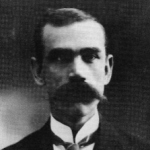
Blog
Topic pages: Politics
September 4, 2020
2015: Saskia (Mees) Tielens, “Review: Guilty as Charged? Mormonism in Nazi Germany David Conley Nelson. Moroni and the Swastika: Mormons in Nazi Germany” Dialogue: A Journal of Mormon Thought, Vol 48 No. 3 (2019): 124–129.
Response to Moroni and the Swastika: Mormons in Nazi Germany wherein David C. Nelson describes the relationship between the Church in Nazi Germany and the Nazi Party. Nelson argues for the most part that it was a positive relationship.
2015: Jonathan Green “Review: Confident Interpretations of Silence David Conley Nelson. Moroni and the Swastika: Mormons in Nazi Germany” Dialogue: A Journal of Mormon Thought, Vol 48 No. 3 (2019): 115–123.
Response to Moroni and the Swastika: Mormons in Nazi Germany and Jonathan Green addresses problems with how Nelson tells the history.
2014: Russell Arben Fox, “Book Review: Mormons and the American Liberal Order” Dialogue: A Journal of Mormon Thought, Online, November 17, 2014.
Response to Seeking the Promised Land: Mormons and American Politics in looking at the political preferences of members.
2013: Blair Hodges, “Review: Common Ground, Different Opinions: Latter-day Saints and Contemporary Issues” Dialogue: A Journal of Mormon Thought, Online, October 16, 2013.
Response to Common Ground, Different Opinions, which is a collection of essays talking about how even when members agree on certain issues, disagreements still happen especially regarding politics.
2012: “Introducing Religion & Politics” Dialogue: A Journal of Mormon Thought, Online, May 3, 2012.
An introduction to the blog Religion and Politics, which contains writers who also were a part of Dialogue.
2012: Kristine Haglund, “Watch Editor Kristine Haglund on C-SPAN discussing Mormonism and Politics” Dialogue: A Journal of Mormon Thought, Online, March 15, 2012.
In an attached 1-hour panel during Mitt Romney’s 2012 Presidental Campaign, Editor Kristine Haglund discusses the church and politics.
2012: Gary James Bergera, “Rising above Principle”: Ezra Taft Benson as U.S. Secretary of Agriculture 1953-61 Part 1” Dialogue: A Journal of Mormon Thought,Vol 41 No. 3 (2008): 81–122.
While a member of the Quorum of the Twelve Apostles, Ezra Taft Benson served under both terms of Dwight D. Eisenhower’s adminstration as the Secretary of Agriculture. Gary James Bergera discusses the ups and downs for Ezra Taft Benson during this time period.
2012: Gary James Bergera, “Weak-Kneed Republicans and Socialist Democrats”: Ezra Taft Benson as U.S. Secretary of Agriculture 1953-61 Part 2” Dialogue: A Journal of Mormon Thought,Vol 41 No. 4 (2008): 55–95.
In the second part of a two-part series Bergera describes the struggles that Ezra Taft Benson faced as Secretary of Agriculture.
1997: Claude J. Burtenshaw, “One Nation Under Whose God? How Religion Was Excluded from the U.S. Political System” Dialogue: A Journal of Mormon Thought,Vol 30 No. 3 (1997): 55–95.
Burtenshaw identifies the reasons why in America there is a separation between church and state.
1995: Jeff Blake, “Ernest L. Wilkinson and the 1966 BYU Spy Ring: A Response to D. Michael Quinn” Dialogue: A Journal of Mormon Thought,Vol 28 No. 1 (1995): 163–172.
In the Dialogue article “Ezra Taft Benion and Mormon Political Conflicts”, D Michael Quinn claims that Ezra Taft Benson instigated the 1966 BYU Spy Ring. Blake argues that Quinn is wrong, and that it was actually Ernest L. Wilkinson who was university president at the time.
1993: Gary Bergera, “A Strange Phenomenon, Ernest L. Wilkinson, The LDS Church, and Utah Politics” Dialogue: A Journal of Mormon Thought,Vol 26 No. 2 (1993): 89–115.
Bergera outlines BYU University President Ernest L. Wilkinson’s mixed feelings about remaining at BYU or running for political office.
1993: Michael Quinn, “Ezra Taft Benson and Mormon Political Conflicts” Dialogue: A Journal of Mormon Thought,Vol 26 No. 2 (1993): 1–87.
Quinn outlines the public rift between Ezra Taft Benson and members of the First Presidency and Quorum of Twelve Apostles regarding Ezra Taft Benson’s comments about the Anti-Communist John Birch Society.
1991: John Sillito, “Utah’s Original ‘Mr. Republican’: Reed Smoot: Apostle in Politics by Milton R. Merrill” Dialogue: A Journal of Mormon Thought,Vol 24 No. 3 (1991): 24–25.
In this response to Reed Smoot: Apostle in Politics Sillito describes issues with Senator Reed Smoot’s career in politics.
1989: Alleen Nilsen, “Evan Mecham: Humor in Arizona” Dialogue: A Journal of Mormon Thought,Vol 22 No. 3 (1989):81–89.
Nilsen discusses how when Evan Mecham became Govenor of Arizona, people in Arizona and nationwide came up with political jokes to describe the stuff that he did in office, most notably having to do with race.
1989: Karen Coates, “The Holy War Surrounding Evan Mecham” Dialogue: A Journal of Mormon Thought,Vol 22 No. 3 (1989):66–80.
Coates describes Governor Evan Mecham’s term in office, which was laden with difficulties. During this time period church members were pitted sometimes violently against each other regarding what they felt about Mecham.
1988: Alan Powell, “Politicians, Mormons, Utah, and Statehood. Political Deliverance: The Mormon Quest for Utah Statehood by Edward Leo Lyman” Dialogue: A Journal of Mormon Thought,Vol 21 No. 1 (1988):172–173.
Response to Political Deliverance: The Mormon Quest for Utah Statehood describes the Church’s role in acquiring statehood in Utah.
1987: John D. Nielson, “Christ’s World Government: An End of Nationalism and War” Dialogue: A Journal of Mormon Thought,Vol 20 No. 3 (1987):46–61.
Nielson discusses how things would be different in terms of governments after the Second Coming.
1984: Merwin Swanson, “Political Hacks in the Idaho Territory. Rocky Mountain Carpetbaggers: Idaho’s Territorial Governors, 1863-1890, by Ronald H. Limbaugh” Dialogue: A Journal of Mormon Thought,Vol 17 No. 4 (1984):149–150.
Response to Rocky Mountain Carpetbaggers: Idaho’s Territorial Governors, 1863-1890 wherein Swanson discusses the problems and pros with the book.
1983: Keith Melville, “Feisty Lee—Still Enigmatic: Let ’em Holler: A Political Biography of J. Bracken Lee, by Dennis L. Lythgoe” Dialogue: A Journal of Mormon Thought,Vol 16 No. 2 (1983):136–137.
Response to Let ’em Holler: A Political Biography of J. Bracken Lee which describes the rise and fall of former Utah Politician J. Bracken Lee. Melville particularly focuses on the Church’s role in not only his victories, but also his defeats.
1979: James Clayton, “The Supreme Court, Polygamy and the Enforcement of Morals in Nineteenth Century America” Dialogue: A Journal of Mormon Thought,Vol 12 No. 4 (1979):46–61.
Clayton discusses the history behind The Supreme Court Case Reynolds v. United States (1876), and shares his opinion about what was going on between members in Salt Lake and Americans/the federal government.
1978: Dixie Snow Huefner, “Church and Politics at the Utah IWY Conference” Dialogue: A Journal of Mormon Thought,Vol 11 No. 1 (1978):58–76.
In 1977 the Church sent ten conservative Relief Society women to Salt Lake City’s conference of IWY. The conference was overwhelmed by church members defending church principles.
1974: Eugene England, “Hanging By A Thread: Mormons and Watergate” Dialogue: A Journal of Mormon Thought,Vol 9 No. 2 (1974): 9–18.
England shares how during the Watergate proceedings, church members continued supporting Richard Nixon.
1974: Brent Rushforth, “Watergate: A Personal Experience” Dialogue: A Journal of Mormon Thought,Vol 9 No. 2 (1974): 20–24.
Rushforth was a public interest attorney at the time of the Watergate investigation and describes his investigation into the president and vice president of Northrop Corporation who was distributing hush money payments.
1972: Armand Mauss, “Moderation in All Things: Political and Social Outlooks of Modern Urban Mormons” Dialogue: A Journal of Mormon Thought,Vol 7 No. 1 (1972): 57–69.
Mauss reports on a survey done comparing political preferences between Salt Lake City church members, and church members living in California.
1972: Thomas Alexander, “Reed Smoot, The LD.S. Church and Progressive Legislation, 1903-1933” Dialogue: A Journal of Mormon Thought,Vol 7 No. 1 (1972): 47–56.
Alexander shows that even as a Republican Senator, Apostle Reed Smoot was still voting for Progessive Legislations.
1968: Martin B. Hickman and Ray B. Hillam, “Joseph Smith’s Presidential Platform: The Political Legacy of Joseph Smith” Dialogue: A Journal of Mormon Thought,Vol 3 No. 3 (1968): 22–26.
In 1844 Joseph Smith launched his presidential candidacy, where he was able to put together a platform that clearly outlined his beliefs including the idea of abolishing slavery entirely, which wasn’t popular at the time.
1968: Richard Poll, “Joseph Smith’s Presidental Platform: Joseph Smith and the Presidency, 1844” Dialogue: A Journal of Mormon Thought,Vol 3 No. 3 (1968): 17–21.
In the first part of this Roundtable, Poll shares what steps Joseph Smith took to become an independent candidate in the 1844 presidental election.
1968: Richard B. Wirthlin and Bruce D. Merrill, “Roundtable: The L.D.S. Church as a Significant Political Reference Group in Utah: “Right to Work“ Dialogue: A Journal of Mormon Thought,Vol 3 No. 2 (1968): 129–133.
There was a survey done among both members and nonmembers regarding Right to Work laws. For those who were surveyed, their knowledge regarding the law didn’t matter, the only thing that did really matter was if they were active or not in the church.
1968: George Frederickson, and Alden Stevens, “Roundtable: The Mormon Congressman and The Line Between Church and State“ Dialogue: A Journal of Mormon Thought,Vol 3 No. 2 (1968): 121–129.
The authors discuss in this roundtable their findings of members of the church in Congress.
1967: Eileen Osmond Savdié, “In Opposition to the Two-Party System“ Dialogue: A Journal of Mormon Thought,Vol 2 No. 2 (1967): 149–155.
Savdié adresses issues with how the two major political parties in America are run, considering both the Demorcrats and the Republicans.
1967: Dean Mann, “Mormon Attitudes Toward the Political Roles of Church Leaders“ Dialogue: A Journal of Mormon Thought,Vol 2 No. 2 (1967): 32–48.
Mann discusses President David O. McKay sharing his preference for Richard Nixon and if that shaped public opinion among church members to vote for Nixon.
1966: Garth L. Magnum, “Free Agency and Freedom — Some Misconceptions“ Dialogue: A Journal of Mormon Thought,Vol 1 No. 4 (1967): 42–49.
Mangum adresses the differences between free agency and freedom. One of his main points is that even when freedom is in danger, free agency is not in danger, but the choices that we make with free agency can lead to danger.


 Back to all blog articles
Back to all blog articles


